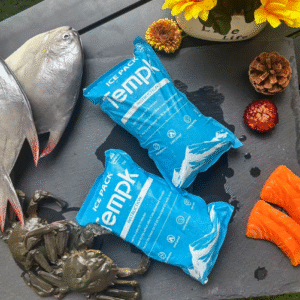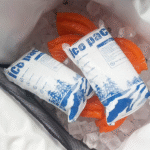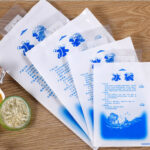No mundo acelerado da logística da cadeia fria, garantir que os alimentos congelados cheguem ao seu destino na temperatura certa é fundamental para manter a qualidade e a segurança do produto. Uma das soluções mais eficazes é o uso de folhas de embalagens de gelo seco, que oferecem benefícios incomparáveis em relação aos métodos tradicionais de resfriamento. Estas folhas não só proporcionam um resfriamento duradouro, mas também garantem que seus produtos permaneçam em perfeitas condições durante o transporte. Neste artigo, exploraremos como funcionam as placas de gelo seco, suas vantagens, e como usá-los de forma eficaz em seus processos de envio.

O que são folhas de gelo seco para alimentos congelados?
Folhas de gelo seco para alimentos congelados são agentes de resfriamento flexíveis feitos de dióxido de carbono solidificado (CO2) que sublimam diretamente do sólido para o gasoso a -78,5°C (-109.3°F). Este processo de sublimação é o que os torna tão eficazes na manutenção de baixas temperaturas durante o transporte. Ao contrário dos pacotes tradicionais de gelo ou gel, gelo seco não deixa resíduos líquidos, evitando danos causados pela água em produtos alimentares sensíveis, como frutos do mar, carnes, e sobremesas.
Essas folhas são altamente personalizáveis e podem ser cortadas para caber em vários tamanhos e formatos de recipientes, fornecendo uma solução de resfriamento confortável e eficiente. A flexibilidade das placas de gelo seco também permite que elas se adaptem ao formato dos produtos enviados, tornando-os uma opção versátil para empresas da indústria de alimentos congelados.
Como funcionam as folhas de gelo seco na logística da cadeia de frio?
As folhas de gelo seco fornecem um mecanismo de resfriamento exclusivo através do processo de sublimação. Veja como eles funcionam:
-
Processo de sublimação: À medida que o gelo seco sublima, absorve calor do ambiente, criando um efeito de resfriamento que pode durar até 72 horas. Isso é muito mais longo do que o gel tradicional ou bolsas de gelo, que apenas mantêm temperaturas frias durante 12-24 horas.
-
Efeito de resfriamento duradouro: Ao contrário dos sistemas de refrigeração à base de água, folhas de gelo seco garantem que o processo de resfriamento esteja livre de qualquer resíduo líquido, tornando-os ideais para o transporte de alimentos congelados e produtos farmacêuticos que exigem temperaturas ultrabaixas.
-
Econômico e Sustentável: Muitas placas de gelo seco são reutilizáveis, oferecendo uma solução sustentável e econômica. A reutilização de folhas reduz o desperdício e reduz o custo geral de envio.
-
Personalizável para diferentes produtos: As folhas de gelo seco podem ser cortadas para caber em qualquer tamanho ou formato, garantindo que os produtos sejam mantidos na temperatura necessária sem desperdício de materiais.
Benefícios do uso de folhas de gelo seco para envio de alimentos congelados
As remessas de alimentos congelados devem atender a regulamentações rígidas de temperatura, e folhas de gelo seco oferecem diversas vantagens importantes:
1. Mantém a qualidade do produto
Mantas de gelo seco garantem que produtos como carnes congeladas, frutos do mar, e o sorvete permanecem na temperatura desejada durante todo o transporte. Ao evitar o descongelamento, essas folhas ajudam a preservar a integridade e a textura dos produtos perecíveis, reduzindo a deterioração e o desperdício.
2. Vida útil estendida
Ao manter os produtos congelados por longos períodos, mantas de gelo seco evitam o crescimento bacteriano e o risco de patógenos de origem alimentar, em última análise, aumentando a vida útil dos itens.
3. Ecologicamente correto
Como o gelo seco é feito de dióxido de carbono (CO2), uma substância que ocorre naturalmente, não deixa resíduos nocivos nem contribui para a poluição ambiental. Isto torna o gelo seco uma opção ecológica para a logística da cadeia de frio.
4. Flexibilidade no manuseio
As folhas de gelo seco são flexíveis, permitindo que caibam perfeitamente em recipientes, maximizando o espaço e garantindo uma distribuição uniforme do resfriamento. Esse recurso é particularmente benéfico ao enviar produtos de diversos formatos e tamanhos.
Como escolher as folhas de gelo seco certas para suas necessidades de envio
Selecionar as placas de gelo seco certas envolve considerar vários fatores para garantir o desempenho ideal:
-
Tamanho e formato das remessas
As placas de gelo seco são personalizáveis, por isso é essencial escolher o tamanho certo para o seu envio. As folhas podem ser cortadas para se adaptarem a diferentes formatos e tamanhos de produtos, fornecendo cobertura completa. -
Duração da viagem
A duração da viagem de transporte afeta diretamente a quantidade de gelo seco necessária. Para viagens mais longas, folhas mais grossas ou maiores são necessárias para manter as temperaturas frias. -
Armazenamento e Manuseio
Se sua empresa exige armazenamento de gelo seco por longo prazo, opte por folhas reutilizáveis ou com refrigerantes à base de gel, que pode ser recarregado e reutilizado várias vezes.
Melhores práticas para envio de alimentos congelados com gelo seco
Ao usar placas de gelo seco, existem várias práticas recomendadas a serem seguidas para garantir um envio seguro e eficiente:
1. Embalagem e isolamento adequados
Use recipientes isolados para minimizar a transferência de calor do ambiente externo, aumentando a eficácia das placas de gelo seco. O isolamento adequado garante que o efeito de resfriamento dure mais tempo.
2. Siga os regulamentos de segurança
O gelo seco é classificado como um material perigoso, portanto, certifique-se de seguir todas as diretrizes de segurança relevantes, incluindo rotulagem adequada, ventilação, e equipamentos de proteção para manuseio.
3. Monitorar temperatura
Monitore a temperatura da remessa durante toda a viagem usando sensores de temperatura ou registradores de dados. Isso garantirá que seus produtos permaneçam dentro da faixa de temperatura exigida.
2025 Tendências e Inovações no Transporte de Alimentos Congelados
A indústria de transporte de alimentos congelados está em constante evolução. Algumas das últimas tendências e inovações incluem:
Alternativas Sustentáveis ao Gelo Seco
À medida que a sustentabilidade se torna um foco principal na logística, muitas empresas estão explorando alternativas ecológicas ao gelo seco, como refrigerantes de base biológica e materiais de mudança de fase (PCMs).
Integração IoT na Logística da Cadeia de Frio
Sistemas de monitoramento em tempo real alimentados pela Internet das Coisas (IoT) permitir que as empresas monitorem a temperatura, umidade, e outros fatores críticos, reduzindo a deterioração e melhorando a eficiência.
Soluções de refrigeração híbrida
Sistemas híbridos que combinam gelo seco e PCMs oferecem uma solução equilibrada, fornecendo temperaturas ultra-frias no início do embarque e mantendo condições estáveis durante toda a viagem.
Perguntas frequentes
Qual é a diferença entre placas de gelo seco e gelo seco normal?
As placas de gelo seco são flexíveis e projetadas para fácil manuseio, enquanto o gelo seco normal é sólido e normalmente vem em blocos ou pellets. As placas de gelo seco são ideais para manter alimentos congelados em temperaturas ultrabaixas sem deixar nenhum resíduo líquido.
Por quanto tempo as folhas de gelo seco podem manter meus alimentos congelados frios?
As placas de gelo seco podem manter a temperatura por até 72 horas, dependendo do tamanho e isolamento do recipiente, tornando-os perfeitos para remessas de longa distância.
Conclusão e recomendações
As placas de gelo seco são uma ferramenta inestimável para garantir o transporte seguro e eficiente de alimentos congelados. Eles fornecem resfriamento duradouro, são ecologicamente corretos, e ajudar a preservar a qualidade dos produtos perecíveis. Escolhendo as placas de gelo seco certas e seguindo as melhores práticas, as empresas podem reduzir a deterioração, aumentar a satisfação do cliente, e cumprir os requisitos regulamentares.
PRÓXIMOS PASSOS:
-
Avalie as necessidades de sua remessa e determine o tamanho apropriado da folha de gelo seco com base na carga útil e na duração da viagem.
-
Siga as melhores práticas de embalagem e segurança para garantir que seus alimentos congelados permaneçam dentro da faixa de temperatura exigida.
-
Mantenha-se atualizado sobre as novas tendências e inovações na logística da cadeia de frio para manter uma vantagem competitiva no mercado.
Sobre Tempk
A Tempk é líder no fornecimento de soluções de gelo seco de alta qualidade para logística da cadeia de frio. Nossos produtos são projetados para atender aos rigorosos requisitos da indústria alimentícia, garantindo que seus produtos congelados permaneçam em ótimas condições do início ao fim.
Chamado à ação:
Entre em contato com a Tempk hoje mesmo para obter soluções personalizadas para otimizar seu processo de envio de alimentos congelados com folhas de gelo seco.























